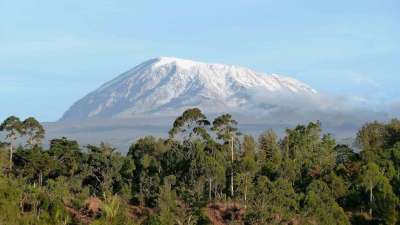Tanzania enjoys mainly two seasons—dry and rainy seasons. The rainy season comes in long rains, from March to May, and short rains in November and December. The dry season lasts from June to October, with short dry seasons in January and February. The ideal period to visit Tanzania depends on your interests and the adventures you plan to have. From hiking Mount Kilimanjaro, a safari in the UNESCO World Heritage Site of Ngorongoro Crater to an unforgettable wildlife expedition in Serengeti National Park. Planning and choosing the perfect time to visit can heighten your Tanzania experience, so come with us as we provide a month-by-month weather guide to the best time to visit Tanzania.

Photo credit: Magdalena Kula Manchee
January
In January, the temperature starts rising, but you may experience some light showers, mostly at night. It’s a good time to witness the iconic wildebeest migration as the calving season on the Ndutu plains begins. You can see millions of wildebeest, gazelles, and zebras moving to search for green pasture. During this month, the prices are also lower.

Photo credit: Pandora Pictures
February
The weather in February is still very much similar to that in January—it is mainly dry with little showers to refresh the terrain. This is the best time to ascend Kilimanjaro’s ethereal heights and go on safaris in the southern and northern parks like the Serengeti. Discover our Kilimajaro Walking Holidays, Serengeti Safaris or our other Tanzania Walking Holidays.
Another great thing about this month is it’s the peak of the calving season—you get to see many newborn wildebeest and other younglings.
March
For most of March, the daytime temperatures are hot, and the weather is generally dry. The beginning of the month is great for activities such as trekking and beach trips. However, the long rainy season begins as the month nears its end.
April to May
Travellers are advised against visiting in April and May since the long rains fully begin. Safaris are challenging, and many lodges will be closed. At this time, the wildebeest herd is heading towards the central Serengeti, with the rain affecting their pace and direction.
June
In June, the heavy rainy season ends, and lush greenery decorates the terrains, making it a great time for birdwatching, particularly in the southern regions. The great migration also veers towards the north in the Serengeti’s Grumeti area.
July
July is the start of Tanzania’s peak travelling season. The weather and landscapes are perfect for an unforgettable wildlife experience. The favourable temperatures and gorgeous terrains result in crowds and high prices. You can avoid this by visiting remote parks like the Selous. Nevertheless, this month is also a lovely time to visit Zanzibar. It is recommended to book lodges early and pack appropriate clothing, including thicker clothes for early morning and late night activities, as those tend to be cooler during this month.
August
The month of August is filled with warm and dry days. It is also the month where you have a greater chance of catching sight of The Big Five because wildlife begins to search for water sources, making it easier to know where they are heading. You’ll also be able to view stunning Flamingos at Lake Natron.
September
September marks the last month of the peak season. This month, the wildebeest and zebra are spread out across the Serengeti. You may even witness the vicious cycle of life play out here as you behold wildebeest swimming desperately to avoid encountering crocodiles. This month will be very busy so if you want less traffic, you might need to visit the parks in the south.
October
Two things happen in October: the dry season ends and the short rainy season begins. This month is still a good time to visit the beach and embark on treks, but mainly at the start of the month before the rain begins. In October, the migration moves to Kenya, but there are still fascinating animals around water sources.
November
In November, the short rains begin properly, but the refreshing showers mostly happen in the evenings. The rain colours the plains green, and spotting the birds is easy. So, while birdwatching can be quite rewarding in November, hiking Kilimanjaro is not advisable because of the rain. However, many lodges are still open, unlike with long rains. So you can take advantage of the prices and good deals available now.
December
A lot is going on in December. The short rains continue, mostly pouring in the afternoons and evenings. There is lush vegetation resulting from the rain. The migration starts heading south to Ndutu this month. Also, December is a festive period as they celebrate Christmas and New Year.
Time for the Ultimate African Adventure
Tanzania is a beautiful country, and the best time to visit is generally the peak season from June to October, but knowing what each month offers gives you an edge in ensuring your holiday is the best it could ever be. And if you’re keen on enhancing your experience, contact us today!












